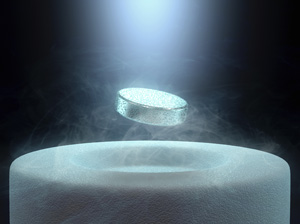Aug. 28, 2015 Research Highlight Physics / Astronomy
Electrons that stick together, superconduct together
A newly uncovered electron-pairing mechanism challenges accepted wisdom in superconductor physics
 Figure 1: Conventional superconductors only achieve their zero-resistance state at close to absolute zero. A better understanding of the physical mechanisms responsible for the binding of electron pairs that gives rise to superconductivity could lead to the discovery of room-temperature superconductors. © ktsimage/iStock/Thinkstock
Figure 1: Conventional superconductors only achieve their zero-resistance state at close to absolute zero. A better understanding of the physical mechanisms responsible for the binding of electron pairs that gives rise to superconductivity could lead to the discovery of room-temperature superconductors. © ktsimage/iStock/Thinkstock
The discovery of a surprising feature of superconductivity in an unconventional superconductor by a RIKEN-led research team provides clues about the superconducting mechanism in this material and thus could aid the search for room-temperature superconductors1.
Superconductors conduct electricity with zero resistance, and hence they could potentially revolutionize electric motors, generators and utility grids. However, scientists have yet to discover a material that becomes superconducting at ambient temperature—all known superconductors operate only at cryogenic temperatures, making them impractical for general applications. Unfortunately, progress toward achieving the goal of room-temperature superconductivity has been hindered by scientists’ limited understanding of the fundamental mechanism responsible for the emergence of this remarkable physical phenomenon.
Superconductivity occurs as the result of pairs of electrons binding together in such a way that they act as a single quasiparticle. In conventional superconductors, which include elemental materials that become superconducting at temperatures very close to absolute zero, the binding force is provided by vibrations in the atomic lattice through which the electrons travel.
Yet not all superconductors behave this way. In unconventional superconductors that do not fit the conventional model, this binding force develops in a different manner and various mechanisms have been proposed for it. One such mechanism is the magnetic or spin fluctuation of the electrons themselves, which binds electrons in pairs through the entanglement of electron spins. However, recent experiments have shown that this mechanism cannot explain the superconducting state in the quintessential unconventional superconductor CeCu2Si2.
Inspired by this result, Michi-To Suzuki and Ryotaro Arita from the RIKEN Center for Emergent Matter Science, in collaboration with Hiroaki Ikeda from Ritsumeikan University in Japan, investigated the mechanism of electron pairing in CeCu2Si2 from first principles.
Their research focused on the unique ‘multipole’ behavior of CeCu2Si2. The electrons in CeCu2Si2 can interact by entanglement of both spin and orbital states, resulting in multiple possible configurations or degrees of freedom.
This multipole behavior was already understood to give rise to certain exotic physical phenomena, but to their surprise, the researchers found that multipole fluctuations can also produce bound pairs of electrons, and are responsible for superconductivity in CeCu2Si2. This kind of electron binding may also be present in the recently discovered class of high-temperature iron-based superconductors.
“We found that the origin of the unconventional superconductivity in CeCu2Si2 is an exotic multipole degree of freedom consisting of entangled spins and orbitals,” says Suzuki. “The finding urges us to reconsider the mechanism of superconductivity.”
References
- 1. Ikeda, H, Suzuki, M.-T. & Arita, R. Emergent loop-nodal s+--wave superconductivity in CeCu2Si2: Similarities to the iron-based superconductors. Physical Review Letters 114, 147003 (2015). doi: 10.1103/PhysRevLett.114.147003
